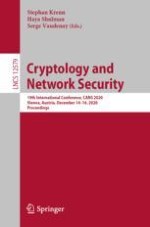2020 | Book
Cryptology and Network Security
19th International Conference, CANS 2020, Vienna, Austria, December 14–16, 2020, Proceedings
Editors: Stephan Krenn, Haya Shulman, Serge Vaudenay
Publisher: Springer International Publishing
Book Series : Lecture Notes in Computer Science
